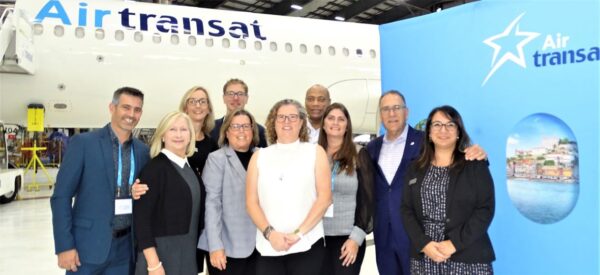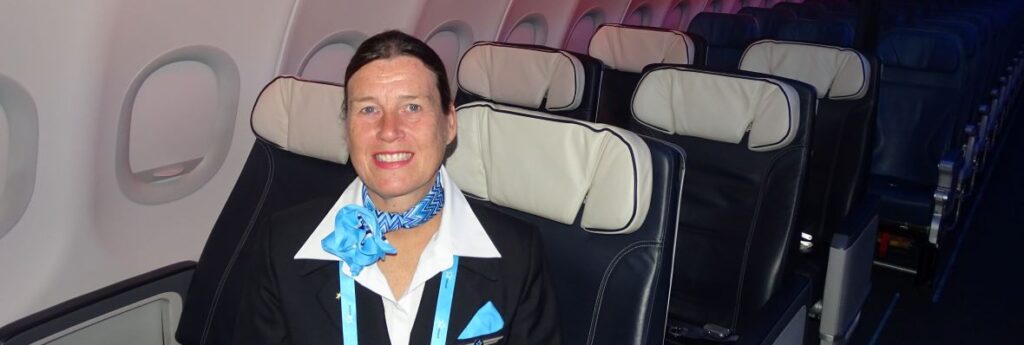It’s been a tumultuous nearly three years for Transat, starting with Air Canada’s takeover intentions that ultimately were derailed (deplaned?). Then, of course, a historic and horrible pandemic. However, the iconic Canadian company – 35 years young next month – is “still standing,” even if not in the way it expected it would be back in 2019.
But the past is the past, even if it informs the present, and Transat execs came together last week to show off a new plane to select trade partners in Toronto, but also for a state-of-the-company update and crystal ball glimpse of the future.
Indeed, wondering about the future is a fair question, says Transat chief sales and marketing executive Joe Adamo, stating, “We’ve been to hell and back in the travel industry (during the pandemic), but I’m here to tell you, we’re still standing. We are what we were, but we’re transforming.”
So, where does Transat stand?
• As of Aug. 31, the company counted 4,300 – and increasing – employees, though down from 5,000 pre-pandemic. However, efficiencies and technology mean the company likely will not fully reconstitute its former compliment of staff.
• Among those employees, Transat has almost entirely new leadership, including Annick Guérard (president and CEO), who replaced a retiring company co-founder Jean-Marc Eustache in 2021.
• Entering the pandemic with half a billion dollars in the bank and no debt, Adamo admits the company “burned through cash” during the global health crisis, leaving it “leveraged to the hilt” and having taken on debt, including government loans to repay.
• Circumstances have required Transat to “turn the page” on its former aspiration of owning hotels, instead focussing on three core products: airline, tour company, and distribution (travel agencies). In sum, Adamo says, “We are a very different company (in 2022) with a different balance sheet.”
• Nevertheless, sales are brisk this fall, reaching and surpassing 2019 levels, and the company is “confident” about 2023. As for 2022 – a year that started strongly as travel restrictions eased and pent-up consumer demand surged, then lulled during a summer of industry (and airport) staff shortages that caused travel disruptions, then boomed again – it has been “a year of stabilizing and transforming the business.”
“And,” declares the Transat exec, “we’re succeeding.”
So, where is Transat headed?
Towards efficiencies and a focus on its three core products, particularly the airline, for as Adamo observes: “Focussing on the airline first and foremost is vital… It all starts with an airline that is well run, that is efficient. Without a well-run airline, there is no tour operator, and with no tour operator there is no sense in us being in the retail business, because retail is still the go-to channel for selling ITC in this country. So that’s why we focus on the airline – because it all starts with that!”
Additionally:
• Regional retrenchment: Lacking the “scale to meaningfully compete” in Western Canada, Transat has retrenched in the east – Ontario, Quebec, and Atlantic Canada. Adamo says when the time is right, the company may return to the west, but beyond a small service feeding into Toronto and Montreal, that won’t be soon, though “maybe (beyond 2025) as we regrow the fleet, who knows?” He adds that instead the airline will grow in the east, including having a “compelling offer” in the market this winter and by next year offering capacity comparable to 2019. The decision to recalibrate regionally was difficult, “but absolutely the right choice for us!” says Adamo.
• Fleet: Nothing less than a “massive transformation” of the fleet is under way, with the current roster of aircraft already 40% younger than pre-pandemic thanks to the retirement of older “warhorse” A310s, and older A330s, to be replaced by 12 Airbus321neos (first introduced in summer 2019). By 2025 four extended long-range aircraft will start arriving with the capability of directly reaching destinations like Athens and Rome, plus the Middle East and North Africa.
The fleet will also be focussed entirely on Airbus (with the exception of a couple of short-term leased Boeings), which will reduce costs through maintenance efficiencies and pilots who can be certified to fly more than one aircraft model. This mixed fleet flying capability will be a “game changer from an operational point of view,” says Adamo.
• Network: With a renewed focus on eastern Canada, the airline will also transform its network by “densifying” routes, including South and Europe. Another mandate is to “do a better job” of feeding domestic flights into Toronto and Montreal for Europe flights. Following a beefed-up Florida program and inaugural service to California, a stronger US program is in the offing, including developing the US market through use of Sixth Freedom rights to feed into its European routes.
Adamo says Transat will also be endeavouring to move away from the “extreme seasonality” that saw a lot of its routes “go dark” during shoulder seasons for commercial reasons. “But we’re really trying to level that off – our swings were too extreme,” he says. A key to doing so will be better aircraft utilization by optimizing how and where planes are being used to ensure “more turns,” thereby allowing planes to run more routes.
• Partnerships: The airline will also continue to develop and expand partnerships, like its arrangements with WestJet, and more recently Porter Airlines, to similarly connect Canadians onwards to Europe or Transat’s sun markets.
• Connectivity: Adamo says Transat plans to similarly “raise its game” with its own divisional “connectivity” by better exploiting its own network, such as channeling European passengers on to the South or US destinations through Montreal and Toronto.

• Call centre: Despite the pride of being named North America’s Best Leisure Airline for 2022 in the prestigious annual Skytrax awards, Adamo acknowledges that the company has still has some “shortcomings,” notably in the area of customer service. Stating that the pandemic “laid bare the inefficiency of legacy systems” in the travel industry – which were particularly prevalent during the summer “when the industry really took it on the chin” – he says matter-of-factly, “Our current (call centre) is unacceptable,” adding, “I do apologize; I would have thought that we would be in better shape at this point. We are not.”
He adds that, “While perhaps not perceptible, you have to believe me, it (caller wait time) is getting better… every week. You have my commitment that we are deploying every resource necessary to get our heads above water…”
Citing ubiquitous staffing shortages, Adamo assures that problems are in no way related to cost-cutting and that Transat is endeavouring to attract new employees by all means possible, including offering higher salaries, and by investing heavily in technology as the way of the future. He estimates that simple online capabilities (such as being able to check inventory) could reduce the number of calls by 40,000-50,000 annually, thereby easing wait times when contact with a person is necessary. “Self service,” he says, “is a huge, huge deal!”
New brand image
With so much that’s new, it’s only natural that the tour company would seek a new image. Based on the tagline, “Travel Moves Us,” Adamo says that Transat is positioning itself as a facilitator of travel rather than simply “vacations” – an image that is being introduced in a new fall advertising campaign that is its first in three years.
“We are a leisure-first airline, although we do have some business travellers, but the position here is we’re going beyond vacations,” says Adamo. “Leisure travel is more than vacations, it’s VFR… it’s not just fly and flop on the beach. It’s more than that, and that’s what we’re aspiring to. So, we move from vacations to travel, and hoping that we can help our customers to foster openness in every sense of the word.
“We think ‘Travel Moves Us’ works on two levels: the travelling public can recognize themselves in the adverts – it speaks to them because travel moves them.
“But it also works for us a brand because we travel moves us, literally and figuratively. That’s what we’re trying to say!”

